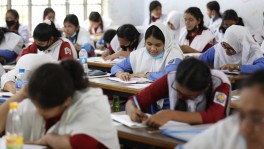Women in vulnerable jobs down 16pc in a decade
Despite the decrease in the number of women in vulnerable jobs, they still outnumber the men doing such jobs

Moklesa Begum works 12 to 14 hours a day at a construction site. She works as a day labourer, which means she is not paid if she does not turn up for work on any particular day. She is usually paid Tk300 a day.
"I know this job is very risky for me. I usually get exhausted as I work. Sometimes it seems intolerable. But what else can I do to make a living?" Moklesa told The Business Standard.
"My elderly mother and two children are dependent on me. If I do not work and earn money, they will die," she said.
Moklesa is among thousands of women in the country who are engaged in vulnerable employment, which is characterised by inadequate earnings, poor working conditions, low productivity and lack of social security.
The good news, however, is that the number of women doing vulnerable jobs in Bangladesh has decreased by 16.54 percent in the last 10 years, the World Bank said.
The World Bank's findings, based on International Labour Organisation data, show that 83.27 percent of the total number of employed women were engaged in vulnerable jobs in 2010. Now, it is 66.73 percent.
Executive Director Zafrul Hasan of the Bangladesh Institute of Labour Studies appreciated the decline in women doing vulnerable jobs, but said it is very difficult to reduce such employment because its nature is different.
"After the Rana Plaza disaster, there have been some positive changes in terms of workplace safety and security of women doing vulnerable jobs. Monitoring of working conditions has increased," he said.

"Moreover, there have been some improvements in compliance issues and awareness," added Zafrul.
Data from the Bangladesh Bureau of Statistics reveal that the number of women working in the readymade garments sector has decreased by 10.68 percent in the last four years.
Data from the Labour Force Survey show that overall female participation in the labour force has remained almost steady between 2010 and 2017, with a slight dip in 2013.
Women accounted for 36 percent of the total labour force in 2010, and that increased slightly to 36.3 percent in 2016-17.
Shackled to vulnerable jobs
Despite the decrease in the number of women in vulnerable jobs, they still outnumber the men doing such jobs. Men comprise 49.9 percent of the vulnerable job workforce.
Women still take up vulnerable employment simply to survive, because there is a lack of decent employment opportunities.
"Nowadays women work in construction sites even at midnight. At least it is better than not having any job. Women are doing these vulnerable jobs just to make a living," said economist Zahid Hussain.
He said women are doing such jobs even in the police department.
"There are women who work in the anti-terrorism unit. It is very risky for them even though it is formal employment," he added.
Zahid said job risk in the informal sector is different from that in the formal sector.
"In the informal sector, there is no job security and there is uncertainty about retirement benefits. The problems are not related to jobs; they are related to the identity of the worker," added the economist.


 Keep updated, follow The Business Standard's Google news channel
Keep updated, follow The Business Standard's Google news channel
















